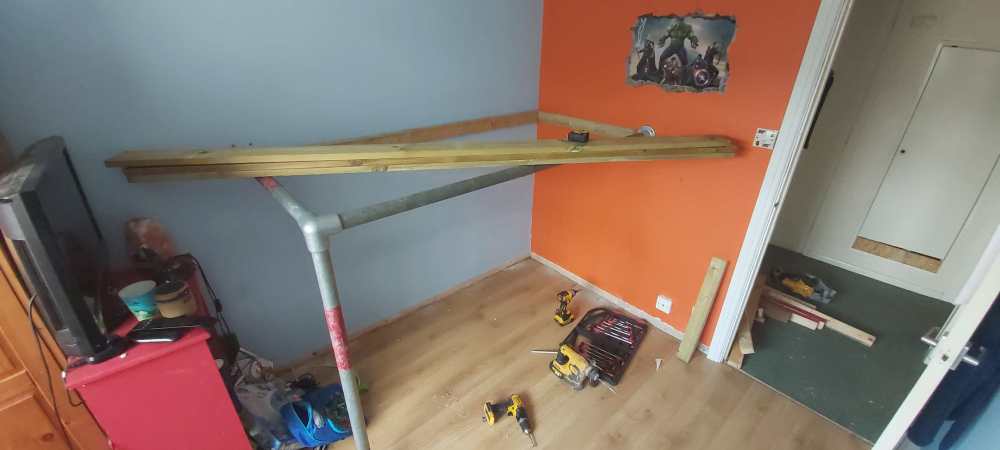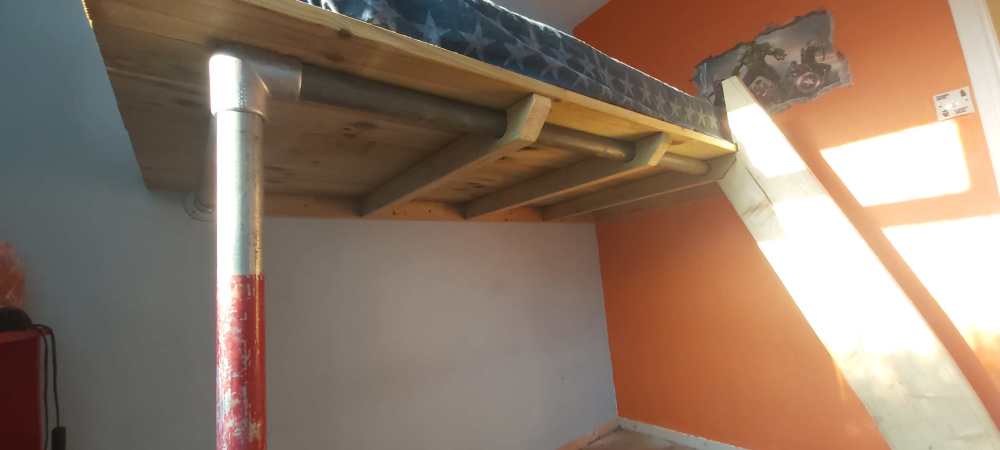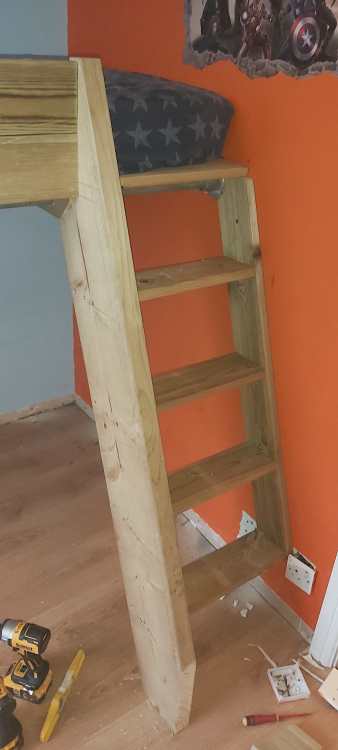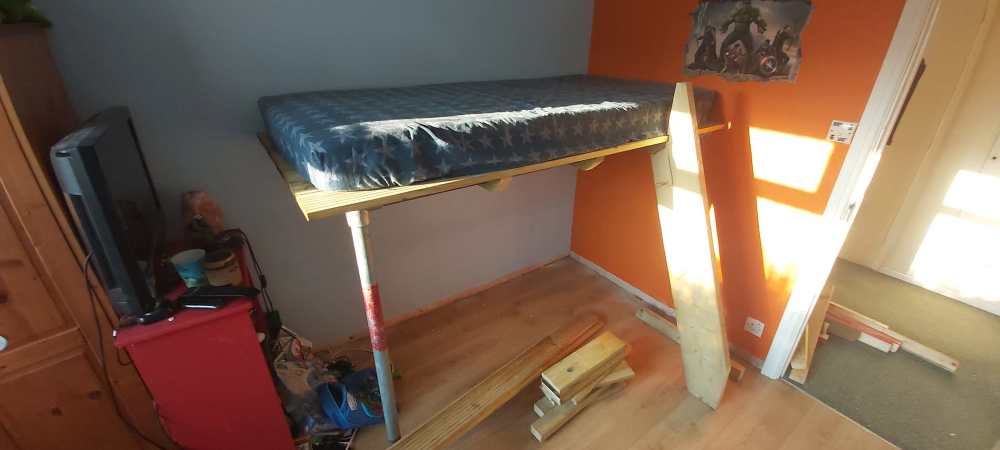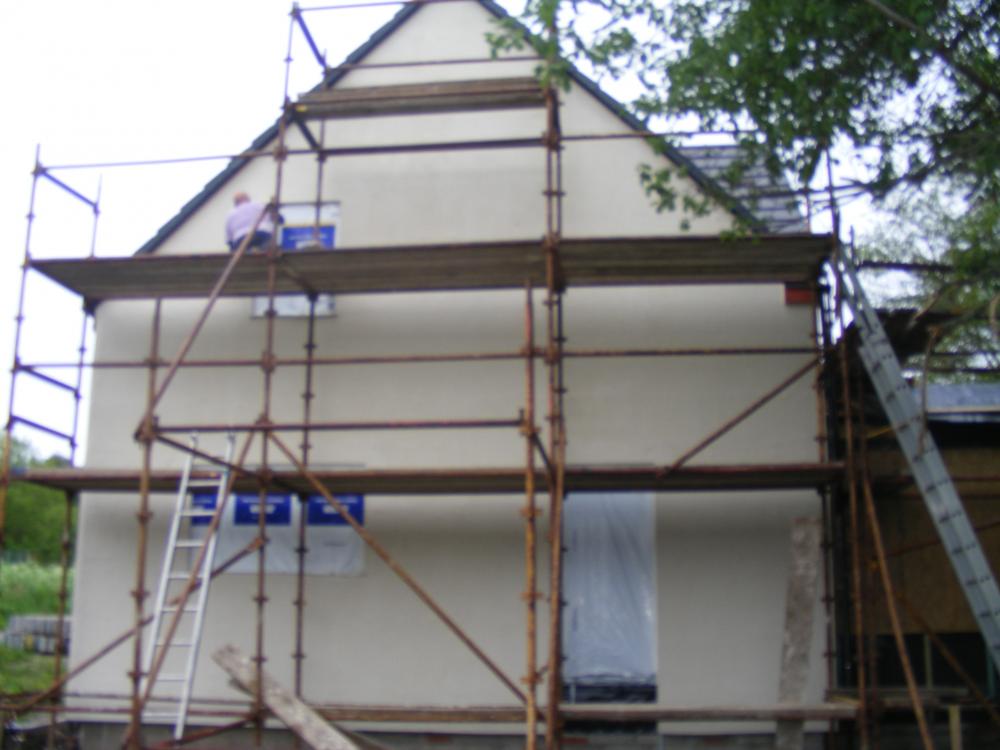Leaderboard
Popular Content
Showing content with the highest reputation on 09/04/24 in all areas
-
No planner is going to come down with a tape measure These things usually come to light when a neighbor complains Your pretty safe to do as they have told you Follow your neighbors line3 points
-
The external dimension of your extension can match the external dimension of your neighbours’ extension. If you want more, submit a Section 73/Variation of Condition application.2 points
-
Hi All, I have to replace the glass units in my 1st floor windows and because it's the old school, the beads are outside. I have to get to the window from the outside. I think the ladder is to risky to work on, I think I buy this tower scaffolding. I have seen some scaffolding made of aluminium and also a scaffold on wheels. If I get the guys to do it it will cost me £600 to replace 4 units (or more!) while if I do it myself it will be £300 for the scaffolding + cost of the units + my time of course. What do you think?1 point
-
When the scaffolding came down and I could see it looked like I imagined it would.. Until that moment I had sleepless nights thinking it would look a mess, and stand out like a sore thumb on a nice little street1 point
-
1 point
-
1 point
-
I enjoyed the whole process. But I rarely look back, just keep looking and moving forward. Did lots myself, when I had trades I spent all the time on site, clearing up, being on the spot to make the 1001 decision. We were in almost a year to the day from starting, but 3 years later my to do job list is nearly complete.1 point
-
1 point
-
The day we moved in, our 2yr old walked in through the front door, cried, turned around and said he wanted to go home. Now, with another wee man in tow, they are always happy and excited to walk in through that same front door. Only took 2 years lol.1 point
-
A warm roof is so much better and easier when dealing with flat roof upstands. Assuming that stud on top is forming some kind of parapet?1 point
-
We’ve had this exact issue with our flat roof design. We are going with 304mm posi rafters with warmcell for our pitched roof. Originally we were going to do the same with the flat roof portion but then another BH member pointed out the need to ventilate this. Then came the issue that cross ventilation with a parapet wall around the top is incredibly difficult to detail successfully. I decided to switch to a much simpler warm roof design with PIR on top. Any reason you’re not going warm roof for the flat roof? Much easier to detail.1 point
-
if this is a plan from a well known timber frame suppler... and the upper surface is external then you need to allow ventilation across that top surface between it and the final external membrane IN which case you need to in build another layer of osb on battens to place the final membrane and allow air to flow across this cavity1 point
-
Ok. a bigger washer won't really help, in fact it is more difficult to get it flat. You have a tiny hole to fill. The screw fills most of it so I suggest you just bodge it with silicone and 'glue' the screw into place. Some into the hole and hand turn the screw in, then slowly with a spanner as there will be little to no resistance. If you want to glue the washer down to then , no harm. Use good silicone mastic. Get a known brand. clear.. One that says it is for outdoor use, stays flexible for ever, and is UV resistant. You could add a small, angled stripe of silicon just uphill of the screw to divert any water that is running down the crown , away from the screw.1 point
-
Pipes to my 4 year old shower thermostatic shower mixer developed water hammer. Bled the system without success then my plumber nephew suggested replacing the flow cartridges in the mixer. Suggested buying a new unit as was just as cheap and easy as sourcing and buying new cartridges. Unfortunately it has two outlets being an external unit - flexible & rainfall heads- so needed new cartridges. Phoned the manufacturer, Marflow, got straight through to the after sales service dept, based in UK, not some useless overseas call centre. Chap supported the idea of replacing the flow cartridge but recommended replacing flow & temperature at same time. Didn’t have proof of purchase as builder bought the items I selected but I did have the quote which was good enough for them and I was sent two new cartridges for free, arrived within a couple of days. Fitted and problem solved. What ever happened to good customer service like I received.1 point
-
1 point
-
When we were buying our current house we discovered that the owners had not signed off building work which they had done in 2012. Our solicitor required the owners to get the work signed off for our peace of mind and so that the documentation will be complete whenever we come to sell. So the owners had to go on their knees in penitence to the county council. The planning department said they would need to inspect the work. They came and found that the work that was done not only infringed the terms of the planning permission which was given but it also infringed terms which had been introduced after the owners had applied for the planning permission! So the owners then had the choice of either quickly getting contractors in to modify the work that was done to bring the building up to the planning officer's requirements, or lose us, their buyers, and probably other potential buyers also. They chose to get the modifications done. And went through hell! For example, one of the completely unexpected things they were required to do was fit a fire-extinguishing sprinkler system throughout the whole house, which meant taking up all the carpets on the first floor and making holes in the ceilings above the first floor so that the pipes could be laid to sprinkler points above each floor. They also had to prepare a huge space inside what was a well-shelved lean-to for a huge tank in which to store the standby water-supply for the sprinklers. So, the moral is: keep completely to the planning permission that has been given, or reach a new written agreement with the council.1 point
-
Yes I don't know, because I do not know what the designer had in mind. One assumes either that it is an incomplete dwg - there is nothing shown above the firrings - or, as you surmise, the OSB is in the wrong place. I always like a howling gale on the top side of a cold roof, although I have seen designs for apparently unventilated, fully-Warmcel-filled roofs, which seem to work OK. As that is drawn I cannot tell whether the 'air gap' has ins and outs (cross-ventilation) anyway. Has the detail been drawn by a company specialising in Warmcel-ins'd roofs? Warm roofs are theoretically much better, I feel, but the scope for poor execution due to misunderstanding the concept can be significant. If you get someone who is really good at insulated cold flat roofs you *may* get a better job than asking them to do a warm roof that they have never done before. Is it really a full-depth thermal bridge, or is the tail of the arrow masking a 'mitigating' piece of insulation? Certainly it wants to be 'cloaked' as best it can.1 point
-
One of my neighbours checked the footprint of his new rear kitchen extension AFTER the foundations had been excavated and filled with concrete and found the rear depth/projection was 0.5 metre more than the approved plans. As expected Building Control were not concerned (ie. only interested in Regs) and local Planning Dept said to go ahead as long as he consulted adjacent neighbours about it and confirmed that they did not object to the extra 0.5m....which luckily they were fine about it...much to builders relief! The kitchen design did have to be slightly re-jigged though to use the extra space!1 point
-
Like to come back with an outcome on posts. Got chatting to building certifier who said to leave it alone. Thermal blocks on the inner walls are “completely overkill” and will have no noticeable difference1 point
-
Actually perhaps I imagined it as a planning rule . Anyway my build footprint moved and grew and no one checked .1 point
-
My more serious comments are: 1 - I have a Zarges Reachmaster, which is a touch more expensive than yours but probably more convenient. Recommended, and very portable. Mine has corner braces. 2 - I bought it from the Buildhub Marketplace. Try putting a request there. Someone may be all scaffold-towered out, or have finished the bits they need it for.1 point
-
Remember the difference between height of platform and working height. Some access is described as being 3m platform, but gives you a realistic reach of 4.5m. I see lots of people paying for towers and plant that's way bigger than needed.1 point
-
1 point
-
The whole flat felt roof looks very poor. I really dislike totally flat roofs. That looks in poor condition, witness patch repairs and staining where it looks like it puddles. There is an upstand along most of the edge of the gap, and that ends near the sloping roof as if it is designed to allow the water to run off at that specific point into the gap, but with no proper means to deal with that run off. If it were mine, I would re roof that flat bit totally. You have enough of a step between the flat roof and the sloping roof, to put a bit of fall on the "flat" roof so it drains to the right of the picture, and an upstand ALL the way along the edge of the gap to stop water draining down into the gap. And re roof with something better than mineral felt.1 point
-
Your plans are not clear. You really need a full set, upstairs and downstairs, and plans for existing and for what you are seeking to end up with. It is also not clear what is the original footprint when the house was built. That is what planning rules are based on. You are permitted a certain amount of single storey rear extension under permitted development, but without knowing which part is the original part of the house it is impossible to say if your proposed new extension meets that or not.1 point
-
Accuracy ; what’s that ? I walked my build perimeter out - said “ that’ll do “ - “ near enough “ . I then added 0.5m width to the build . I then went 0.5m higher than the plans . Enforcement officer was called by neighbors regarding height . As officer knew nothing about the build I told him I had added ufh and the insulation had increased the build height . Problem solved . Tape measures stretch in the heat as does my stride .1 point
-
Exactly this - a friend, local to us currently building had a very similar issue these past few months. The neighbour complained that he believed the standalone garage ridge height was higher than it should have been given the plans. Planning came out and were satisfied it wasn't BUT found the garage footprint was actually 1 metre further to the Left / Right than it should have been. There was a genuine possibiilty that the garage had to be taken down and "shifted" back a metre - Thankfully, for them, the matter was resolved by a further "amendment" to the plans and a much reduced cost - it caused 3 months of delays mind So, as @Nod says, you should be OK providing your neighbour is either on board or unaware!1 point
-
That's what my architect said when I phoned him in a panic that our house was 150mm too high. His view is that anything within the dimensions of a concrete block were acceptable. I still dropped the ridge beam by 100mm tho!1 point
-
Yeah, it’s an interesting question. How accurate do you have to match the plans? To +-mm? No that would be silly. To +- cm? Also mostly silly - complain to a brickie that he’s out by a cm? I don’t think so. To +- 10cm then? Seems reasonable. Same question also applies to ground levels, ridge heights etc - although ‘flat ground’ (depending on the size of the area) could I think vary by 20-30cm, and still be ‘flat’. These are my guesses anyway.1 point
-
Hi all, first post after coming across this forum looking for advice. Seemed a good idea to join up and try get answers to those questions that I can neither get a black and white answer for! Or so it seems! planning in and approved for rear and side extension of our 1930s semi. Been in two years now and we’ve spent that time working away on the rooms that won’t be part of the extension. anyway questions to follow in the relevant category’s Dan1 point
-
That is an understatement. It is piss poor and needs to be replaced with a Google site search.1 point
-
This is great in theory but in practice architects don't give a hoot about value engineering. During the design stage I asked my architect about costs and he flat out refused to comment and told me to appoint a QS to cost the project. Which is completely unhelpful. If I was building a house again I would get the SE and builder involved far earlier, to do a proper sanity check over the plans, and rely far less on the architect.1 point
-
Good choice. Your boards need to be self supporting over 1200mm. It should be easy to find "past their best" scaffold boards for next to nothing that have rotten ends so are no good for scaffold but will cut down for what you want.1 point
-
1 point
-
The forum search isn't the best. Here, try this https://www.google.co.uk/search?q=aerobarrier+site%3Aforum.buildhub.org.uk1 point
-
Isn’t it easier to build it correctly in the first place. seems like a quick fix for a problem that shouldn’t exist1 point
-
1 point
-
Digression but have you seen how narrow some of the joints are on some victorian stuff. Very much like 6mm on some houses makes you appreciate how good they were at setting out and cutting.1 point
-
Don't assume just because its not AAC that its not a thermal block, as they also come in medium dense which look like any other block: https://www.huwsgray.co.uk/lightweight-concrete-blocks/stocks-insulite-solid-breeze-block-100mm-73n-10609-2851049 Agreed they don't perform like AAC, but they're still classed as thermal blocks, with higher strength whilst keeping the budget low1 point
-
It is easy to fix an anchor into the wall. I like the ones which are a threaded fixing left in the wall, and a screwed-in eye. You shouldn't need it if the feet are on a solid base, but it stops any wobble and adds confidence.1 point
-
All scaffold will wobble and risk falling over if you push it to extremes. I bought a load of Kwikstage when building my house, and when I sold it, I kept enough to scaffold one wall of my house. the scaffold lives on a rack in my garden and the boards are stored dry in a custom made enclosure under a raised decking area outside the back door. Much more heavy and needs 2 to assemble it compared to a lightweight tower. But even that needs some bracing at height. You can see in this picture scaffold up the gable wall and the square frame sticking out towards you in this photograph exists just to give it some more bracing.1 point
-
I bought a cheap (£600) scaffold tower, makes doing anything outside easy. Takes me an hour to put it up, half that to take it down, fits in the car and I store it under the stairs in a self made box.1 point
-
So firstly, I can't tell you whether the design is particularly complex yet as I don't have one... 😉 It is an award-winning Architectural Practice, with more than one office, but it's not based in London. It was the most costly of all our quotes from our shortlist, but they were also streets ahead of their nearest competition in how comfortable we felt to be in their hands. All of us make decisions about where we want to spend our budget, and how much we're prepared to spend on each item. Personally, this project will be my third home ever, and my first self-build - I don't move around a lot! Many others on this site are on their second, third, and more builds and have lived in many different houses. I don't have that wealth of experience, so I've chosen to engage someone in a specialist field to help me. I work in a senior position in the IT industry, and that's what my clients do every day of the week. Sure they can do some things themselves, but they trust that our teams have experience they don't and will perhaps approach something in a way they had not considered, improving their experience, reducing their risk, and providing an excellent return on their investment. This is what I am looking for from my Architect and why I was very careful about their choice. Cost is very relative; when you look at the work they will be doing, and the seniority and experience of the people I'll be working with, then I'm very comfortable that it is good value. For those interested in the process, I have a design brief that lists all the things we'd like to achieve and the way we'd like to live, a small number of photos that show the design aesthetics we are drawn to, a list of known constraints (for example, there's a 3" PVC water main with a 6m easement that goes through the plot) and a bubble diagram that has all our desired rooms and their relationships to each other drawn on it. Our architects will take that and use their skill and experience to bring it to life for us in the specific context of the plot, its orientation, the surrounding buildings and features, the options for access, and a hundred and one other variables that all have a potential impact, many of which I would just not have had the skill or experience to consider. Of course, assuming our appeal is ultimately successful... 🤣1 point
-
We knew pretty much exactly the layout and 85% of the external design and we then shortlisted two architects from looking at lots of their websites. We then met the chosen two on site and broadly talked through our plans. One was right on our wavelength and was happy to do just the parts we wanted (site survey, planning drawings and application support, then building regs level design and liaison with structural engineers). We got a quote for each bit and then went with it. We figured the relationship and matching values and attitudes were too important to shop around on price. Why not work out what you want then go meeting?1 point
-
It very much depends on the Architect or Architectural Practice and who will need to be involved in your discussions and designs as to the costs to expect, as does the size and complexity of your proposals. As a very rough ballpark, as a percentage of build cost, you would typically be looking at 7% to 15%, or if engaging by the hour, £50 - £150 per hour. Of course, this depends on the seniority, skill, and experience of the Architect or Practice. For our own potential project, for RIBA Stages 0-2: Brief Development and Concept Design, we'll be spending £9K+VAT, and that gets us the various site visits, discussions with planners, development of 3 alternative simple massing design options in plan and basic 3D form, discussions on options, meetings, quotes from professionals and consultants required, etc. For RIBA Stage 3: Developed Design, it will be a further £9K+VAT and that will take us to a full Technical Details Consent application and will get us more developed drawings based on our design choices, Passivhaus assessment, collaboration with other consultants, discussions with planners, detailed Design and Access Statement, and refined site and dwelling drawings including everything needed for an application. This is for a design brief with a 220m2 main house and a 60m2 garage/workshop on a 0.25 acre site. It's a very personal choice whether to involve an Architect or not, but for us, these initial costs are an investment in their expertise and experience and we hope, as the anecdote goes, that we'll recoup that cost many times over in the value they bring.1 point
-
Hi, As a small step towards repaying the valuable advice I have received on this forum I thought I'd share the attached document, which I hope will be useful and/or interesting to forum users. I am a planner by trade, working in local authority. My SB is on a relatively small, highly inaccessible plot neighboured by mature trees, and tightly bordered by existing houses. The plot was a 'detached' back garden of sorts that came as part of the deal (and something of an afterthought) when we bought our current house. Nobody had ever even considered the prospect that it could be a building plot, and for many years I discounted the idea myself due to the restrictions listed above. Five years ago, having outgrown our house and exhausted other options, I decided to at least try to self build on the plot. I obtained permission at the first time of asking (albeit not quickly and not without having to make a tweak or two). Everyone, without exception, from family to neighbours to building tradesmen to delivery drivers to other planners, have commented on how 'well' I've done to get permission. Some of them probably thought I'd made a mistake, or that the Council did, or that there was some old pals act involved because I am a planner myself (even though I don't work in the borough where I am building, and it really, really doesn't work that way anyway). They are all wrong. I obtained permission because I did the thing that planners spend their working lives telling others to do - I read the relevant planning policies, designed a development that was in line with them, then demonstrated as much in the application. That is what the attached statement does, it goes from global to national to regional to local policy, then explains the thought process behind my design, in that context. I cannot tell you how many architects, developers and would-be planning consultants fail to design development proposals specifically to meet planning policies, and then spend ages moaning, appealing, resubmitting, and generally wasting time. I can't promise that if you follow the thought process in my document you'll certainly get planning permission, but I hope you find it a useful insight into how a planner approached self-build, and specifically the matter of seeking planning permission on a plot that the rest of the world had discounted. Cheers 647910914_DesignandAccessStatementRedacted.pdf1 point
-
Glad to see some people have found the statement useful. Something I didn't explain in my original post but which may be apparent anyway, is that once I had a good idea of my preferred design I asked myself: 'If I was the planner assessing this, and if I was being as harsh as I could reasonably be, what would be the specific grounds on which I could refuse it?' The statement is partly an exercise in anticipating those possible grounds of refusal and addressing them in advance. That is easier for me as a planner than for many others, but it's not rocket science. Look at the adopted policies and supplementary guidance on the council website, and read the planning officers report for a few applications in your area to get a feel for how those policies are applied. You'll find that you get the gist pretty quickly, even if you've never looked at a planning policy before. Its not impossible to discuss and debate your plans once they are submitted (though it is increasingly rare to get the chance), but really the idea is to make the most substantive and comprehensive case upfront. It is for the applicant to support their proposal, not for the council to tease out everything that is good about your idea. Ultimately of course, if you've designed something that obviously doesn't meet the policies then it doesn't matter how thoroughly you state your case. Equally, if you've got a design which plainly meets every criteria then you shouldn't need to sell it to the planning office. Most plans sit somewhere in the middle of those two extremes, where there is inevitably a degree of subjectivity, so put the work in to show the extent of compliance with planning policies as part and parcel of your application. You do of course get the odd stroppy or difficult planner, but not half as often as you get a stroppy or difficult applicant! However frustrated you might get, remember that there is a significant difference between making an argument and having one.1 point
-
Let’s hope the review finds someone accountable and suitably penalised.0 points
-
Well that’s a first and not advice I’d give anybody.0 points
-
0 points





